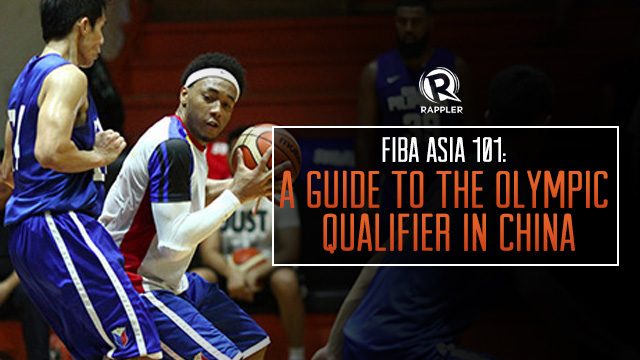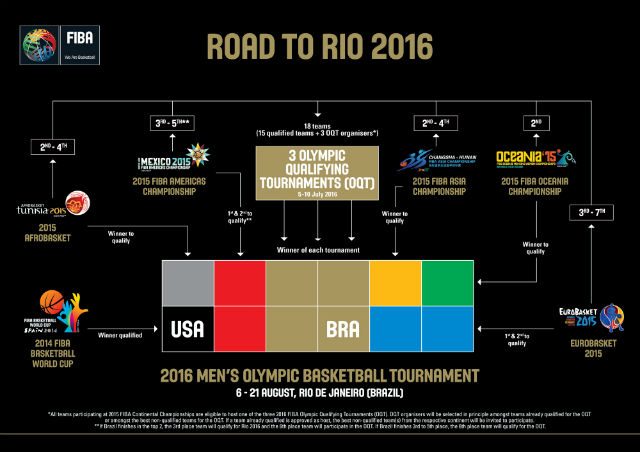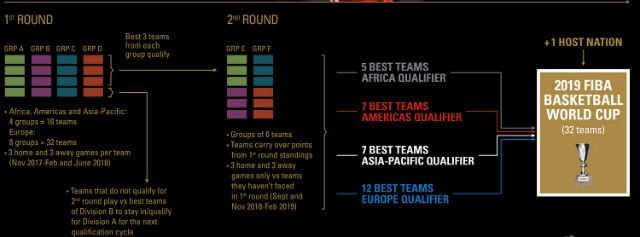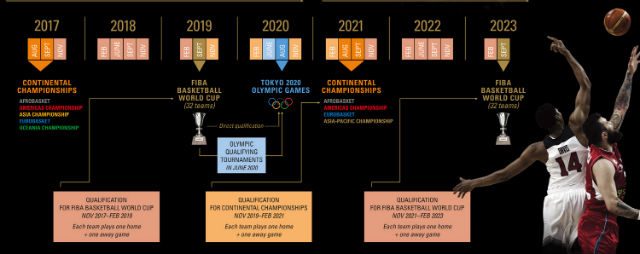SUMMARY
This is AI generated summarization, which may have errors. For context, always refer to the full article.

MANILA, Philippines – The biennial 2015 FIBA Asia Championship will be played from September 23 to October 3 in Changsha, Hunan, China. There will be 16 countries vying for the biggest prize of this Asian tilt – an automatic slot at the 2016 Summer Olympics in Rio de Janeiro.
Top teams expected to make a serious run for the gold medal and the accompanying Olympics spot are reigning FIBA Asia champion Iran, host China, previous bronze medalist South Korea and silver medalist Philippines.
Qualifier for Rio 2016

The gold medalist of this year’s FIBA Asia will automatically qualify for the Rio Olympics.
While the second, third and fourth placers will be relegated to the FIBA Olympic Qualifying Tournament happening in 2016 from July 5 to 16. That qualifying tournament will have 18 national teams from FIBA’s primary events divided into 3 competitions of 6. The winner from each tilt will qualify for Rio 2016.
The Philippines and its national men’s basketball team Gilas Pilipinas are eyeing nothing less than the gold at this year’s FIBA Asia Championship. The Southeast Asian nation has not played in men’s Olympic basketball tournament since 1972.
Iran participated in the men’s basketball Olympics in 2008 while China has been a fixture at the Games since 1976. South Korea saw action together with China in the 1996 Olympics in Atlanta.
Groupings
The 16 national teams are divided into 4 groups.
Group A:
Iran
Japan
Malaysia
India
Group B:
Philippines
Palestine
Kuwait
Hong Kong
Group C:
South Korea
Jordan
Singapore
China
Group D:
Chinese Taipei
Qatar
Lebanon
Kazakhstan
Competition format
According to FIBA.com, all 16 teams will play in a single round robin within their groups for the first round of competition from days 1 to 3. The top 3 teams from each group will move on to the second round. The eliminated teams will play in classification games (13-16).
The second round, happening from days 5 to 6 after one rest day, will be placed once again in two groups (E and F) of 6, where each team will play the 3 new teams they have not yet faced. Win-loss records from the first round will be carried over.
Only the top 4 teams from each group will qualify for the Quarterfinals while those eliminated will play in classification games (9-12).
The final 8 teams will play in the playoffs or final round from days 9 to 11 after a rest day. All games in this round will be in knockout format.
The quarterfinals, happening on day 9, will be a crossover between the top 4 teams of Groups E and F from the second round. The top team from each group will face the bottom team of the other group and so on and so forth, like so:
E1 vs F4
E2 vs F3
E3 vs F2
E4 vs F1
For the semifinals, which takes place on on day 10, the winner between E1 and F4 will face the winner between E3 and F2. While the other semifinals pairing will be between the winner of E4 vs F1 and the winner between E2 vs F3.
The winners in each of the two semifinals brackets will battle gold in the final on day 11. Classification games will be played as well throughout the last 3 days.
Future of FIBA Asia
FIBA Asia will play this kind of tournament format for the last time this year. By 2017, there will be a new competition format and calendar in order to qualify for the 2019 FIBA Basketball World Cup in China as well as in the 2020 Olympics in Tokyo.

Each FIBA World Cup qualification period will be stretched out over two years, meaning the FIBA Asia Championship will also take place over the course of two years. There will be 6 windows per qualification period: November, February, June, September, November, February. Each team, FIBA said, will also have one home and one away game.

Teams from FIBA Asia and FIBA Oceania will also merge in one Asia-Pacific zone for the 2019 World Cup qualification “to ensure competitive games,” according to FIBA.com.
The 2019 FIBA World Cup will also undergo major changes as it veers away from occuring on the same year as the FIFA World Cup as well as increasing its number of teams from 24 to 32. The next basketball World Cup in 2019 will have a total of 7 teams participating from the Asia-Pacific region, which will include Asia and Oceania.
All continental championships after the 2019 World Cup will follow a 4-year cycle. – Rappler.com
Add a comment
How does this make you feel?
There are no comments yet. Add your comment to start the conversation.